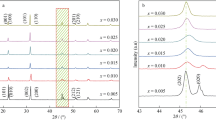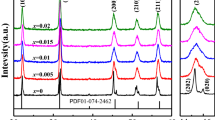Abstract
(K0.5Na0.5)NbO3–Bi(Zn2/3Nb1/3)O3 − xmol%CeO2 [0.97KNN–0.03BZN − xCeO2] lead-free ceramics were synthesized and the phase structure, microstructure and dielectric properties were investigated. Dielectric studies reveal that the 0.97KNN–0.03BZN − 1.0CeO2 ceramics show excellent dielectric properties at a broad usage temperature range (150–350 °C): the dielectric permittivity is near 1900 (at 10 kHz) with the capacitance variation (ΔC/C150 °C) no more than ±10 %; the temperature coefficient of permittivity (TCε) is as low as −162 ppm/°C; the corresponding dielectric loss is less than 2.5 %. These results indicate that the 0.97KNN–0.03BZN − 1.0CeO2 ceramics are promising candidates for high temperature multilayer ceramic capacitor applications.






Similar content being viewed by others
References
H. Kishi, Y. Mizuno, H. Chazono, Base-metal electrode-multilayer ceramic capacitors: past, present and future perspectives. Jpn. J. Appl. Phys. 42, 1–15 (2003)
R.W. Johnson, The changing automotive environment: high-temperature electronics. IEEE Trans. Electron. Packag. Manuf. 27, 164–176 (2004)
P. Hagler, P. Henson, R.W. Johnson, Packaging technology for electronic applications in harsh high-temperature environments. IEEE Trans. Ind. Electron. 58, 2673–2682 (2011)
C. Buttay, D. Planson, B. Allard, State of the art of high temperature power electronics. Mater. Sci. Eng. B-Adv. Funct. Solid-State Mater. 176, 283–288 (2011)
S.J. Zhang, R. Xia, C.A. Randall, T.R. Shrout, R.R. Duan, R.F. Speyer, Dielectric and piezoelectric properties of niobium-modified BiInO3–PbTiO3 perovskite ceramics with high Curie temperatures. J. Mater. Res. 20, 2067–2070 (2005)
S.M. Choi, C.J. Stringer, T.R. Shrout, C.A. Randall, Structure and property investigation of a Bi-based perovskite solid solution: (1−x)Bi(Ni1/2Ti1/2)O3–(x)PbTiO3. J. Appl. Phys. 98, 34108 (2005)
J. Ryu, S. Priya, K. Uchino, High-Tm relaxor ferroelectrics: 0.3BiScO3–0.6PbTiO3–0.1Pb(Mn1/3Nb2/3)O3. Appl. Phys. Lett. 82, 251–253 (2003)
C.J. Stringer, N.J. Donnelly, T.R. Shrout, Dielectric characteristics of perovskite-structured high-temperature relaxor ferroelectrics: the BiScO3–Pb(Mg1/3Nb2/3)O3–PbTiO3 ternary system. J. Am. Ceram. Soc. 91, 1781–1787 (2008)
Y. Li, K. Moon, C.P. Wong, Electronics without lead. Science 308, 1419 (2005)
W.W. Wolny, European approach to development of new environmentally sustainable electroceramics. Ceram. Int. 30, 1079–1081 (2004)
C.C. Kruea-In, G. Rujijanagul, F.Y. Zhu, Relaxor behaviour of K0.5Bi0.5TiO3-BiScO3 ceramics. Appl. Phys. Lett. 100, 202904 (2012)
C. Zhou, X. Liu, W. Li, C. Yuan, G. Chen, Structure and electrical properties of Bi0.5Na0.5TiO3–Bi0.5K0.5TiO3–BiCoO3 lead-free piezoelectric ceramics. J. Mater. Sci. 44, 3833–3840 (2009)
Y. Yuan, C.J. Zhao, X.H. Zhou, High-temperature stable dielectrics in Mn-modified (1−x)Bi0.5Na0.5TiO3–xCaTiO3 ceramics. J. Electroceram. 25, 212–217 (2010)
R. Dittmer, J. Wook, D. Damjanovic, Lead-free high-temperature dielectrics with wide operational range. J. Appl. Phys. 109, 034107 (2011)
R. Dittmer, E.M. Anton, J. Wook, A high-temperature-capacitor dielectric based on K0.5Na0.5NbO3-modified Bi1/2Na1/2TiO3–Bi1/2K1/2TiO3. J. Am. Ceram. Soc. 95, 3519–3524 (2012)
A. Zeb, S.J. Milne, Stability of high temperature dielectric properties for (1−x)Ba0.8Ca0.2TiO3–xBi(Mg0.5Ti0.5)O3 ceramics. J. Am. Ceram. Soc. 96, 2887 (2013)
W.F. Bai, J.G. Hao, B. Shen, Dielectric properties and relaxor behavior of high Curie temperature (Ba0.85Ca0.15)(Zr0.1Ti0.9)O3–Bi(Mg0.5Ti0.5)O3 lead-free ceramics. Ceram. Int. 39, s19–s23 (2012)
N. Raengthon, D.P. Cann, High-K (Ba0.8Bi0.2)(Zn0.1Ti0.9)O3 ceramics for high temperature capacitor applications. IEEE Trans. Ultrason. Ferroelectr. Freq. Control 58, 1954–1958 (2011)
H. Ogihara, C.A. Randall, S. Trolier-McKinstry, High-energy density capacitors utilizing 0.7BaTiO3–0.3BiScO3 ceramics. J. Am. Ceram. Soc. 92, 1719–1724 (2009)
J.B. Lim, S.J. Zhang, N. Kim, High-temperature dielectrics in the BiScO3–BaTiO3–(K1/2Bi1/2)TiO3 ternary system. J. Am. Ceram. Soc. 92, 679–682 (2009)
J.B. Lim, S. Zhang, T.R. Shrout, High temperature capacitors using a BiScO3–BaTiO3–(K1/2Bi1/2)TiO3 ternary system. Electron. Mater. Lett. 7, 71–75 (2011)
N. Raengthon, T. Sebastian, D. Cumming, BaTiO3–Bi(Zn1/2Ti1/2)O3–BiScO3 ceramics for high-temperature capacitor applications. J. Am. Ceram. Soc. 95, 3554–3561 (2012)
C.C. Huang, D.P. Cann, Phase transitions and ferroelectric properties in BiScO3–Bi(Zn1/2Ti1/2)O3–BaTiO3 solid solutions. J. Appl. Phys. 102, 044103 (2007)
N. Raengthon, D.P. Cann, High temperature electronic properties of BaTiO3–Bi(Zn1/2Ti1/2)O3–BiInO3 for capacitor applications. J. Electroceram. 28, 167–171 (2012)
H.L. Du, W.C. Zhou, F. Luo, Phase structure, dielectric properties, and relaxor behavior of (K0.5Na0.5)NbO3–(Ba0.5Sr0.5)TiO3 lead-free solid solution for high temperature applications. J. Appl. Phys. 105, 124104 (2009)
H.L. Du, W.C. Zhou, F. Luo, High Tm lead-free relaxor ferroelectrics with broad temperature usage range: 0.04BiScO3–0.96(K0.5Na0.5)NbO3. J. Appl. Phys. 104, 044104 (2008)
H.L. Du, W.C. Zhou, F. Luo, Design and electrical properties’ investigation of (K0.5Na0.5)NbO3–BiMeO3 lead-free piezoelectric ceramics. J. Appl. Phys. 104, 034104 (2008)
J.B. Zhao, H.L. Du, S.B. Qu, The effects of Bi(Mg2/3Nb1/3)O3 on piezoelectric and ferroelectric properties of K0.5Na0.5NbO3 lead-free piezoelectric ceramics. J. Alloys Compd. 509, 3537–3540 (2011)
F. Zhu, T.A. Skidmore, A.J. Bell, T.P. Comyn, C.W. James, M. Ward, Diffuse dielectric behaviour in Na0.5K0.5NbO3–LiTaO3–BiScO3 lead-free ceramics. J. Mater. Chem. Phys. 129, 411–417 (2011)
H.L. Cheng, H.L. Du, W.C. Zhou, Bi(Zn2/3Nb1/3)O3–(K0.5Na0.5)NbO3 high-temperature lead-free ferroelectric ceramics with low capacitance variation in a broad temperature usage range. J. Am. Ceram. Soc. 96, 833–837 (2013)
D. Jin, P. Hing, C.Q. Sun, Growth dynamics and electric properties of PbTi0.1Zr0.9O3 ceramics doped with cerium oxide. J. Phys. D Appl. Phys. 33, 744–752 (2000)
B. Sahoo, P.K. Panda, Effect of CeO2 on dielectric, ferroelectric and piezoelectric properties of PMN-PT (67/33) compositons. J. Mater. Sci. 42, 4745–4752 (2007)
C. Ju, D.Y. Xu, S.H. Xie, Effect of CeO2 doping on properties of PCrNi-4 piezoelectric ceramics. J. Inorg. Organomet. Polym. 22, 32–36 (2012)
Y. Yuan, E.Z. Li, B. Tang, B. Li, X.H. Zhou, Effects of ZnO and CeO additions on the microstructure and dielectric properties of Mn-modified (Bi0.5Na0.5)0.88Ca0.12TiO3 ceramics. J. Mater. Sci. Mater. Electron. 23, 309–314 (2012)
Y.W. Liao, D.Q. Xiao, D.M. Lin, The effects of CeO2-doping on piezoelectric and dielectric properties of Bi0.5(Na1−x−y K x Li y )0.5TiO3 piezoelectric ceramics. Mater. Sci. Eng. B 133, 172–176 (2006)
D.J. Gao, K.W. Kwok, D.M. Lin, Microstructure, electrical properties of CeO2-doped (K0.5Na0.5)NbO3 lead-free piezoelectric ceramics. J. Mater. Sci. 44, 2466–2470 (2009)
T. Lee, K.W. Kwok, H.L. Chan, Preparation and piezoelectric properties of CeO2-added (Na0.475K0.475Li0.05) (Nb0.92Ta0.05Sb0.03)O3 lead-free ceramics. J. Phys. D Appl. Phys. 41, 155402 (2008)
J.H. Hwang, Y.H. Han, Electrical properties of cerium-doped BaTiO3. J. Am. Ceram. Soc. 84, 1750–1754 (2001)
J.H. Wang, Y.H. Han, Dielectric properties of (Ba1−xCex)TiO3. Jpn. J. Appl. Phys. 39, 701–704 (2000)
Y. Guo, K. Kakimoto, H. Ohsato, Ferroelectric-relaxor behvior of (Na0.5K0.5)NbO3-based ceramics. J. Phys. Chem. Sol. 65, 1831–1835 (2004)
H. Qian, L.A. Bursill, Random-field potts model for the polar domains of lead magnesium niobate and lead scandium tantalite. Int. J. Mod. Phys. B 10, 2007 (1996)
C.J. Stringer, T.R. Shout, C.A. Randall, Structure-property-performance relationships of new high temperature relaxors for capacitor applications, Ph. D. Thesis, The Pennsylvania State University, Ann Arbor, 2006
K. Uchino, S. Nomura, Critical exponents of the dielectric constants in diffused-phase-transition crystals. Ferroelectr. Lett. Sect. 44, 55–61 (1982)
V.V. Shvartsman, D.C. Lupascu, Lead-free relaxor ferroelectrics. J. Am. Ceram. Soc. 95, 1–26 (2012)
Shannon RD, Acta Crystallogr. A 32,751 (1976)
W. Chen, X. Yao, X.Y. Wei, Tunability and ferroelectric relaxor properties of bismuth strontium titanate ceramics. Appl. Phys. Lett. 90, 182902 (2007)
Acknowledgments
This work was supported by the National Natural Science Foundation of China (Grant No. 51072165), the fund of State Key Laboratory of Solidification Processing in NWPU (No. KP200901), Doctor Start fund of Baoji University of arts. & sci. (ZK15044), and the fund of Shaanxi Key Laboratory of Phytochemistry (13JS006).
Author information
Authors and Affiliations
Corresponding author
Rights and permissions
About this article
Cite this article
Cheng, H., Zhou, W., Du, H. et al. Microstructure and dielectric properties of (K0.5Na0.5)NbO3–Bi(Zn2/3Nb1/3)O3 − xmol%CeO2 lead-free ceramics for high temperature capacitor applications. J Mater Sci: Mater Electron 26, 9097–9106 (2015). https://doi.org/10.1007/s10854-015-3597-8
Received:
Accepted:
Published:
Issue Date:
DOI: https://doi.org/10.1007/s10854-015-3597-8




